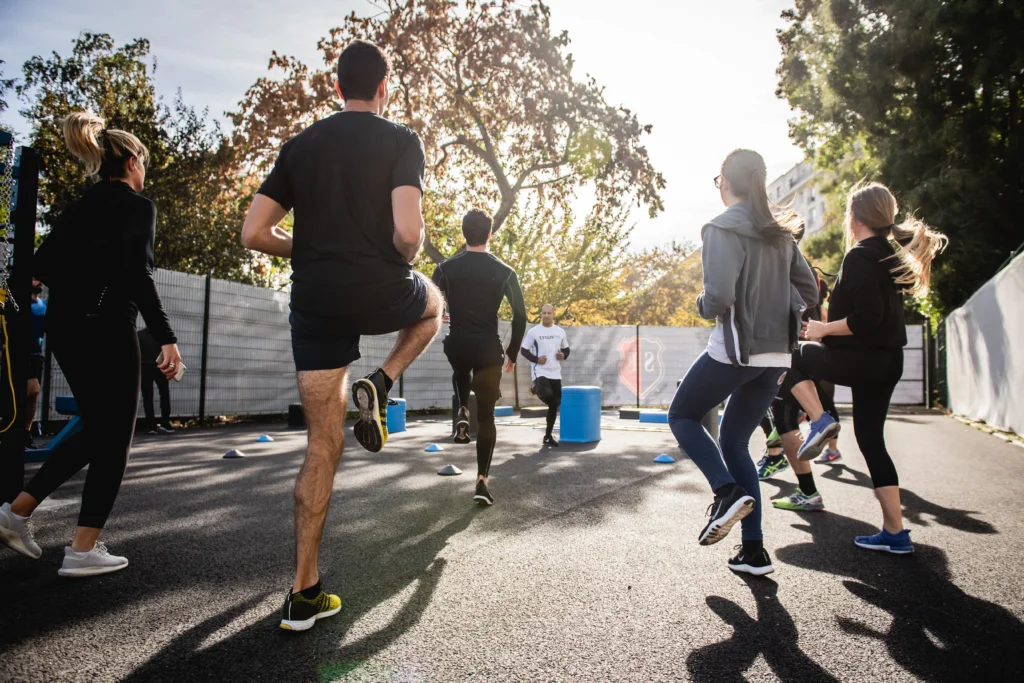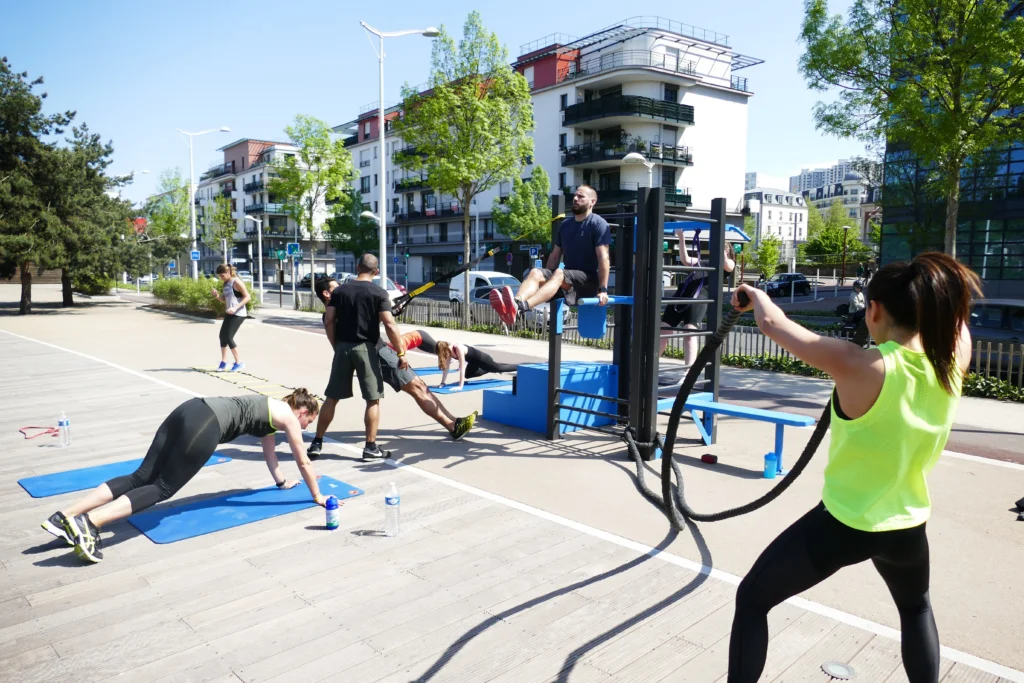Strength Training, Outdoor Fitness
HIIT Tabata Training: High-Intensity Interval Workouts For Outdoor Summer Fitness

The Perfect Fit for Summer
The temperatures are rising, and it’s the perfect time to take your workouts outdoors. HIIT Tabata Training is a popular and effective workout program that will help you make the most of your summer fitness routine. This training involves high-intensity cardio intervals followed by brief periods of rest, which makes it a perfect fit for outdoor summer workouts.
HIIT stands for High-Intensity Interval Training, and Tabata is a specific structured form of HIIT. The technique was developed by Dr. Izumi Tabata in the 1990s to improve athletic performance in Olympic speed skaters.
In this method, participants alternate between short periods of high-intensity exercise with even shorter recovery times. One major benefit of HIIT Tabata Training is that it promotes post-workout calorie burn known as excess post-exercise oxygen consumption (EPOC).
This means you can continue burning calories long after your workout is over. The quick bursts of exercise also aid in cardiovascular health, helping prevent heart disease and other ailments.
what is HIIT and what is HIIT Tabata and How do they work Together?
Table of Contents
HIIT, HIIT Tabata, and How do they work Together?
What is HIIT?
HIIT Tabata is designed to increase your heart rate quickly and keep it high for short periods, followed by a brief rest period before repeating the cycle. The combination of high-intensity intervals with short periods of rest is what makes this workout so effective.
The intensity levels can vary depending on your fitness level and goals but typically involve pushing yourself to your maximum effort during the intense phases. This type of training has been shown to increase the body’s metabolic rate and burn more calories in less time compared to traditional steady-state cardio workouts.
What HIIT Tabata Training?
As mentioned earlier, HIIT stands for High-Intensity Interval Training while Tabata refers to the specific format adopted from Dr. Izumi Tabata’s research work on interval training exercise protocol. The idea behind this form of training is simple: You alternate between short periods (typically ranging from 20-40 seconds) of tough exercises at maximum effort with even shorter recovery periods (typically 10 seconds). The key takeaway here is that during each period of intense activity, you should be pushing yourself as hard as possible, so your heart rate skyrockets above your normal range.
A typical HIIT Tabata session would last anywhere between four to eight rounds comprising two or more exercises, with each exercise lasting 20-40 seconds and a short rest time of 10 seconds. The training is typically intense and lasts between 15 to 30 minutes.
How They Work Together
By combining these two types of training into one workout, you get the best results from both worlds – increased calorie burn from HIIT and improved cardiovascular endurance from Tabata-style training. Alternating between longer intervals with shorter ones can also help prevent boredom as it challenges different energy systems within the body. The key to getting maximum results with this type of workout is maintaining the right intensity levels.
You want to push yourself hard during the work phases but also allow enough recovery time to avoid injury and burnout. With practice, you can find the right balance that works for your fitness level and goals.
The Benefits of HIIT Tabata Training
Increased calorie burn during and after exercise
One of the biggest benefits of HIIT Tabata Training is the increased calorie burn. During a typical workout, you burn calories while you’re exercising, but with HIIT Tabata Training, you continue to burn calories even after your workout is over. This is because the high-intensity intervals in a HIIT Tabata workout cause your body to continue burning calories at an elevated rate for up to 48 hours after your workout.
Studies have shown that HIIT exercises can help increase metabolism and fat burning by up to 30%. So not only will you see quicker results, but you’ll achieve them faster when compared to other workouts.
Improved cardiovascular health
Another important benefit of HIIT Tabata Training is improved cardiovascular health. The high-intensity nature of these workouts increases heart rate and strengthens the heart muscle. This results in a lower resting heart rate (which means less strain on the heart) as well as improved blood flow throughout the body.
In fact, one study found that just two weeks of high-intensity interval training was enough to improve cardiovascular function in healthy adults. By including this training regimen into your exercise routine, it may be possible to reduce your risk for developing cardiovascular disease later on in life.
Time-efficient workouts
With our busy schedules, finding time for exercise can be tough. But with HIIT Tabata Training taking less than 30 minutes per session, fitting in regular workouts becomes much easier.
Instead of spending hours at the gym every week doing steady-state cardio or lifting weights, just 20-30 minutes of high-intensity intervals can produce similar or even better results – making it far more time-efficient than other forms of exercise. Since there’s no equipment needed (other than maybe a stopwatch), HIIT Tabata Training is easy to do at home, in a park, or anywhere else that suits you.

How to Get Started with HIIT Tabata Training Outdoors
Finding a Suitable Location:
One of the best things about HIIT Tabata Training is that it can be done almost anywhere, both indoors and outdoors. However, when it’s summertime and the weather is perfect for outdoor workouts, why not take advantage of it? In order to find a suitable location for your workout, you’ll want to consider a few things.
Firstly, look for open space where you won’t be disturbed or interrupted. A park or field can be great options.
Make sure there is enough room for you to move around freely and safely. If possible, find an area with softer ground surfaces like grass or sand to reduce the impact on your joints.
Equipment Needed (Minimal):
When it comes to equipment needed for HIIT Tabata Training outdoors in the summer, minimal is key! In fact, all you really need is yourself and some comfortable workout clothes and shoes.
If you want to add some extra resistance or challenge to your workout, consider bringing along a set of dumbbells or resistance bands. Alternatively, if you’re doing bodyweight exercises only then no equipment will be necessary at all.
Proper Warm-Up Techniques:
Before jumping right into your HIIT Tabata Training workout outdoors this summer make sure that you properly warm up first! The warm-up helps prepare your body for exercise by increasing blood flow and loosening up tight muscles. A good warm-up should last between 5-10 minutes and include dynamic stretching exercises such as walking lunges or high knees jog in place followed by some light cardio such as jumping jacks or jogging in place with low effort.
Proper Cool-Down Techniques:
Just like warming up before exercising is important; cooling down after exercising is just as important. The cool-down helps gradually bring your heart rate back to its resting state, preventing dizziness or fainting, and reducing the risk of injury caused by abrupt stops. A proper cool-down should last between 5-10 minutes, and include static stretching exercises like hamstring and quad stretches or yoga pose like downward dog or child’s pose.
Take deep breaths in through your nose and out through your mouth to calm down your body and mind. With a suitable location found, minimal equipment gathered, proper warm-up techniques implemented beforehand, you are all set to kick off your HIIT Tabata Training outdoors this summer!
Sample Workouts for Outdoor Summer Fitness
Summer is the perfect time to take your workouts outdoors and HIIT Tabata Training is an excellent way to get fit and have fun in the sun. Here are three sample workouts that will challenge you, burn calories, and leave you feeling invigorated:
Bodyweight Tabata Workout
This workout requires no equipment and can be done anywhere. It involves doing eight rounds of 20 seconds of work followed by 10 seconds of rest, for a total of four minutes. Each round consists of one exercise and you alternate between two exercises.
For example, do squats for 20 seconds, rest for 10 seconds, then do push-ups for 20 seconds, rest for 10 seconds, repeat. Here’s a sample bodyweight Tabata workout:
– Squats – Push-ups
– Lunges – Plank
– Burpees – Mountain Climbers
– Jumping Jacks – Bicycle Crunches
Running Intervals with Burpees
This workout combines running with burpees to create an intense cardio and strength-training session. Find a straight stretch of road or trail that is at least 100 meters long. Run as fast as possible for 100 meters then stop and do five burpees before running back to your starting point.
Rest briefly before repeating the sequence four more times. For an added challenge increase the number of burpees or distance run each round.
Jump Rope Circuit with Sprints
Jumping rope is an excellent cardiovascular exercise that also challenges your coordination skills. This circuit combines jump rope intervals with sprints using distances of either 50 or 100 meters depending on your fitness level. Begin by jumping rope continuously for two minutes before sprinting the designated distance as fast as possible.
Rest briefly before jumping rope again for another two minutes and sprinting again. Repeat the sequence for a total of five rounds.
Incorporating Variety
To prevent boredom and continue challenging your body, switch up your HIIT Tabata workouts regularly. Try adding weights, resistance bands or even a partner to make things more interesting.
You could also choose new locations such as a park or beach to keep your workouts fresh. Remember, the key to success in HIIT Tabata training is consistency and intensity.
Challenge yourself each workout but listen to your body and adjust as needed. By following these guidelines, you’ll be well on your way to achieving all of your fitness goals this summer!

Tips for Success with HIIT Tabata Training Outdoors
Stay Hydrated in the Heat
One of the most important things to keep in mind when doing HIIT Tabata Training outdoors during the summer is to stay hydrated. The heat can cause you to sweat profusely and lose a lot of fluids, so it’s essential to drink enough water before, during, and after your workouts. Dehydration can lead to fatigue, dizziness, and even heatstroke, so make sure you bring plenty of water with you wherever you go.
If you’re doing a more extended workout or running/biking long distances, consider bringing a hydration pack or storing water at certain checkpoints along your route. Additionally, incorporating electrolyte-rich drinks like coconut water or sports drinks can help replenish lost minerals and prevent cramping.
Listen to Your Body and Adjust Intensity as Needed
When doing high-intensity workouts outdoors during the summer months, it’s crucial to listen to your body’s signals and adjust intensity as needed. If you start feeling light-headed or dizzy during a workout, take a break in the shade or stop altogether if necessary. Pushing yourself too hard can lead to injury or other health problems.
Remember that everyone’s fitness level is different; just because someone else is running faster doesn’t mean you should be trying to keep up with them if it doesn’t feel right for your body. Do what feels comfortable for YOU and gradually increase intensity over time.
Incorporate Variety to Prevent Boredom
HIIT Tabata Training is an excellent way to get in great shape quickly, but doing the same workout repeatedly can become tedious over time. To prevent boredom while still reaping all of its benefits – try mixing up your routine by adding new exercises or switching up the order of existing ones. You can also try different outdoor locations to add variety to your workouts.
Instead of always doing sprints in the same park, try running up a nearby hill or through a nature trail. By adding some variety, you can keep your workouts exciting and challenging while still seeing progress.
Don’t Forget About Recovery
It’s important not to overlook the importance of recovery when doing HIIT Tabata Training outdoors. Make sure to stretch after every workout and incorporate rest days into your routine to help your muscles recover properly. Additionally, incorporating self-massage techniques like foam rolling or using a massage ball on tight areas can help ease soreness and prevent injury.
And lastly, getting enough sleep is essential for recovery and overall health – aim for at least 7-8 hours per night. By following these tips for success with HIIT Tabata Training outdoors during the summer months, you’ll be able to have safe workouts while still pushing yourself towards achieving your fitness goals.
Frequently Asked Questions about HIIT Tabata Training Outdoors
Can beginners do this type of workout?
Yes, beginners can definitely do HIIT Tabata Training outdoors. While the workouts may be intense, they can be modified to suit all fitness levels.
It’s important to start slow and work your way up, especially if you’re new to exercise or haven’t done high-intensity workouts before. You can start with shorter intervals and fewer sets, as well as lower intensity movements.
It’s also important to listen to your body and adjust the workout as needed. Don’t push yourself too hard too soon, and take breaks if necessary.
As you get stronger and more comfortable with the movements, you can increase the intensity and duration of each workout. Some beginner-friendly exercises for HIIT Tabata Training outdoors include bodyweight squats, lunges, jumping jacks, and mountain climbers.
Remember that every person is unique, so what works for one person may not work for another. If you have any health concerns or injuries, it’s always best to consult a doctor before starting any new exercise program.
How often should I do these workouts?
The frequency of your HIIT Tabata Training outdoors depends on your fitness goals and current fitness level. For those looking to lose weight or improve cardiovascular health, 3-4 times a week is recommended. However, it’s important not to overdo it – rest days are just as important as workout days in preventing injury and allowing your muscles time to recover.
It’s also okay to mix in other types of exercise like yoga or strength training on some days for balance. Remember that consistency is key – even if you only have 10-15 minutes a day for a quick HIIT Tabata session outdoors, doing it regularly will lead to improvements in overall fitness.
Incorporating HIIT Tabata Training outdoors into a routine
If you’re incorporating HIIT Tabata Training outdoors into your fitness routine, it’s important to plan accordingly. Make sure you have a suitable location and equipment, such as a stopwatch or interval timer.
You’ll also want to make sure you’re properly warmed up before starting each workout, which can include light cardio or dynamic stretching. Cooling down with gentle stretches will help prevent soreness and stiffness.
It’s important to remember that HIIT Tabata Training outdoors is just one piece of the puzzle when it comes to overall health and fitness. Eating a balanced diet, getting enough sleep, and staying hydrated are all important factors in achieving your goals.
Conclusion: Why You Should Try HIIT Tabata
It’s Effective and Efficient
One of the main reasons you should try HIIT Tabata training is because it is incredibly effective and efficient. By incorporating both high-intensity intervals and the Tabata protocol, these workouts are designed to maximize calorie burn during and after exercise. Plus, since most HIIT Tabata workouts can be completed in just 20-30 minutes, they are a great way to fit in a challenging workout when you don’t have much time.
It’s Accessible Anywhere
Another reason to try HIIT Tabata training is that it is accessible anywhere. Whether you prefer to work out at home, at the gym, or outdoors, these workouts can be adapted to fit your needs. In fact, doing HIIT Tabata training outdoors can be a great way to enjoy some fresh air while pushing yourself physically.
It’s Customizable
One of the best things about HIIT Tabata training is that it is entirely customizable. You can adjust the intensity of each exercise according to your fitness level and goals, making these workouts suitable for beginners and advanced athletes alike. Plus, with so many different exercises and variations available, you can easily switch up your routine so that it never becomes repetitive or boring.
It Will Help You Achieve Your Goals
Ultimately, the reason why you should try HIIT Tabata training is that it will help you achieve your fitness goals faster than other types of workouts. Whether you want to improve your cardiovascular health, increase strength and endurance, or simply lose weight and tone up for summer, regular HIIT Tabata sessions will get you there quicker than traditional cardio or weightlifting alone. Check out this HIIT Vs Steady Cardio article for more HIIT!
Try incorporating some HIIT Tabata workouts into your fitness routine and see for yourself how effective, efficient, customizable, and accessible they can be. With a bit of dedication and consistency, you’ll quickly start to see the results you’ve been dreaming of!



